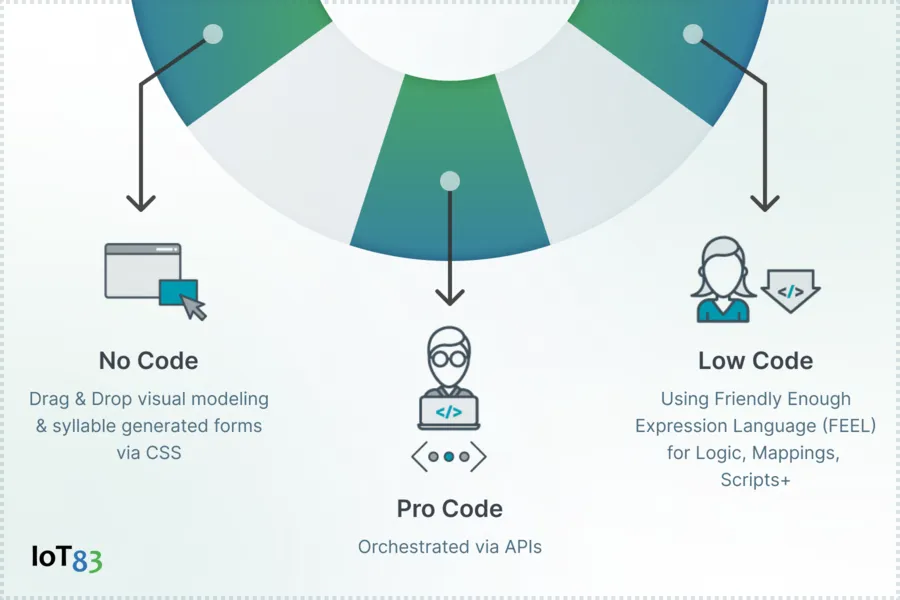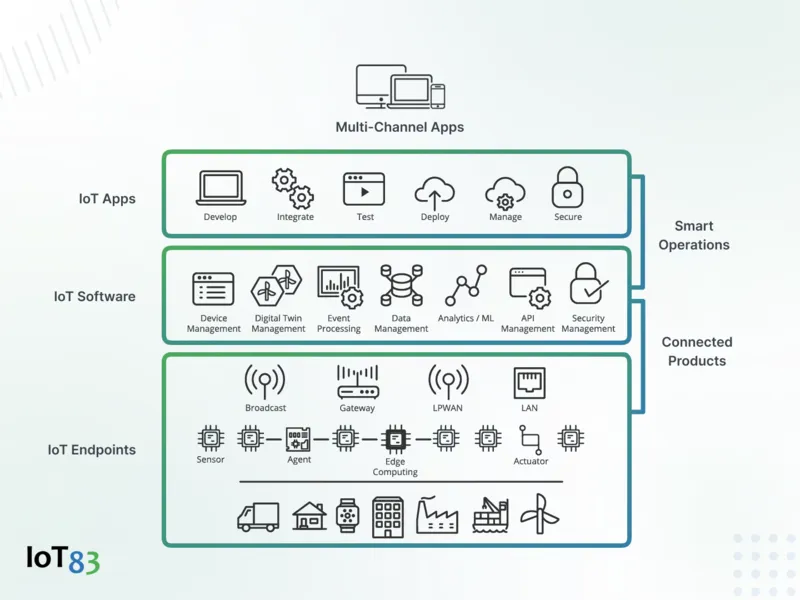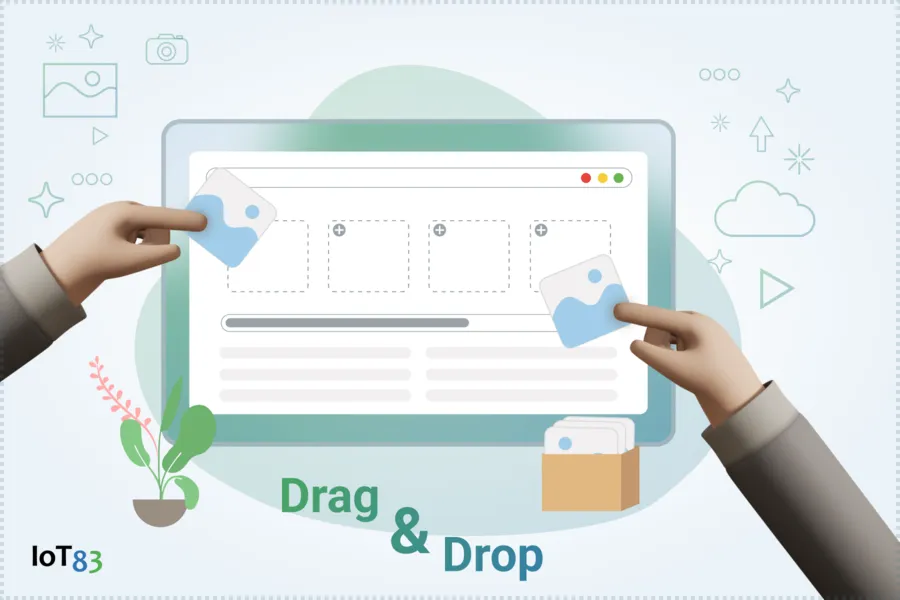
A few years ago, software development was reserved mainly for professionals who deeply understood technology, often bolstered by formal education and substantial experience. However, the technology landscape has undergone significant changes, opening up various pathways for individuals with diverse skills and backgrounds to create increasingly sophisticated and high-performing products.
In the present day, almost anyone can construct software and websites, even with limited knowledge of the intricacies involved in the development process. One such approach is through the utilization of low-code and pro-code development.
The question arises whether Industrial OEMs should place their confidence in the well-established traditional development methods or explore the more accessible avenue of low-code development, or should they go for the pro-code way to build sophisticated custom IoT solutions. Alternatively, they may contemplate a combination of both approaches.
The ultimate answer, as always, hinges on the particular requirements and priorities of the specific business case at hand. OEMs must thoroughly assess the advantages and disadvantages of both low-code and pro-code approaches to make the most suitable decision.
Within this comprehensive guide, we will delve into the fundamental distinctions between low-code and pro-code development, assisting you in making an informed choice regarding the approach that best aligns with your project. Furthermore, we will immerse ourselves in the cutting-edge realm of the Flex83 Application Enablement Platform (AEP), a revolutionary platform designed to bridge the divide between low-code and pro-code development—enabling manufacturers to embrace business transformation.
First Thing First—What are IoT Applications?
IoT applications are compatible with IoT devices and can be tailored to meet various industries and sectors, spanning manufacturing, healthcare, industrial automation, smart homes and buildings, automotive, and wearable technology. Notably, there’s an increasing trend in incorporating AI and machine learning into IoT applications to imbue devices with enhanced intelligence.
Four Layers of IoT Application Architecture
IoT architecture consists of four fundamental layers:
- Sensing Layer – This layer encompasses sensors, devices, and actuators responsible for receiving, processing, and transmitting data related to physical and environmental parameters over a network.
- Network Layer – Within this layer, you’ll find Internet/Network gateways and Data Acquisition Systems (DAS). Advanced gateways play a critical role in connecting sensor networks to the internet and also handle various essential gateway functions like malware protection, filtering, and decision-making.
- Data Processing Layer – This serves as the IoT ecosystem’s processing unit, where data undergoes analysis and pre-processing before being forwarded to the data centre. Edge IT, or edge analytics, becomes relevant at this stage.
- Application Layer – Data centres or the cloud serve as data management hubs where end-user applications, spanning healthcare, agriculture, farming, aerospace, and more, are responsible for managing and utilizing the data.
No Code vs Low Code vs Pro Code

Low-code development, as a development methodology, doesn’t necessitate developers manually coding every aspect of an application. Typically, low-code platforms abstract segments of code into visual elements, allowing users to manipulate these components through drag-and-drop tools. It’s crucial to distinguish low-code from no-code, as the former often involves manual coding at specific points.
On the other hand, “pro-code” denotes the traditional approach of professional development, where trained software engineers manually write code in adherence to best coding practices.
What Types of Projects are Using Low-Code?
The adoption of low code is occasionally hindered by concerns regarding its perceived lack of flexibility. Some businesses must question whether low-code is feature-rich enough to meet their custom application development needs. However, an industry survey has revealed that 50% of respondents employ low-code to construct web apps or portals intended for partners and customers, while 49% utilize it for employee-facing web applications. Moreover, low code finds applications in creating mobile apps for customers, employees, and partners. Approximately 31% of businesses have employed low-code to extend or replace their existing legacy platforms.
Importance of Low-Code
The statistics above underscore the relevance of low-code for organizations in developing critical applications for their business. Low code is precious when time-sensitive web and mobile apps are required to serve business partners and customers effectively.
Low-Code Use Cases
Low-code has several prominent use cases:
Digital Core Platforms: They can be employed to develop business-critical solutions, support digital re-platforming, and modernize legacy systems. Low code enhances the agility of digital core platforms and facilitates effective governance and risk management.
Consumer Digital Experiences: Low-code tools enable the creation of engaging self-service applications, captivating user experiences, and appealing portals for customers. They contribute to the reduction of delivery times and the development of robust products based on user feedback, thereby addressing current and future consumer needs.
Digital Operations: Low-code platforms can create exceptional mobile and web workforce apps, operational dashboards, workflows, and employee portals. This streamlines operations reduces time-to-market, bridges IT skill gaps, enhances efficiency, optimizes company processes, and promotes transparency across various operational facets.
Moreover, it’s important to note that low code doesn’t limit the incorporation of the latest technologies like blockchain, Artificial Intelligence (AI), or the Internet of Things (IoT). In a survey, 69% of respondents reported using low-code to expedite digital transformation and innovation, 55% employed it to reduce IT backlog and increase business responsiveness, while 38% aimed to reduce dependency on hard-to-find technical skills. Other goals included safeguarding against technology changes (16%), moving away from legacy systems (19%), and enabling citizen developers (21%).
What Types of Projects Should Use Pro-Code?
Using pro-code development is unavoidable, given the diverse scenarios and conditions in software development that don’t fit a single, universal pattern. These complex, unique cases make it impractical to create drag-and-drop components to address every nuance. Present-day software development centres on platforms, stacks, databases, data sources, APIs, network layers, and security mechanisms orchestrated to build client-server solutions.
Simultaneously, the creation of secure, scalable custom applications and the development of protected authentication infrastructures with sophisticated user interfaces require the expertise of qualified professionals. While a low-code system can manage the underlying technical stack, encompassing elements like the container platform, hosting, micro-services, database servers, client applications, workflow objects, APIs, security protocols, libraries, and various artefacts, it still leaves the critical task of defining the application’s logic.
For example, in the retail sector, pro-code is essential for accurately executing complex pricing calculations for thousands of products stored across multiple warehouses, each supplied by dozens of providers. Pro-code allows for the configuration of an integrated suite of microservices to centralize the intricate purchasing regulations. Such complex workflows often surpass the capabilities of existing low-code tools, making pro-code the ideal choice for seamlessly integrating system records and meticulously documenting data flows. Pro-code empowers organizations to leverage the diverse skill sets of their teams fully.
Challenges in Developing IoT Applications

Your organization may be exploring harnessing IoT technology to improve operations and deliver innovative products and services. This endeavour involves the development of IoT applications or software that integrate sensor data with machine learning and predictive analytics technologies to create intelligent, context-aware, and proactive user experiences for employees, customers, and partners.
However, building these IoT applications, often referred to as Smart Apps, presents significant challenges. IoT application development involves a wide array of diverse technologies. IoT solutions typically consist of a complex and varied mix of IoT endpoints, platforms, back-end systems, and data sources, including sensors, actuators, processors, embedded software, local and long-range connectivity, middleware, apps, analytics, and machine learning.
Moreover, creating IoT applications requires specialized skills that are often in need of more supply. Developers must not only be well-versed in their organization’s IoT platform and its underlying services but also possess an understanding of big data and machine learning technologies essential for processing real-time data streams. They must also collaborate with the business to experiment with innovations and rapidly iterate on solutions, given that IoT represents uncharted territory. These aspects demand a substantial investment of time and effort, and the rapid rate of change further compounds the challenges for enterprise IT teams.
When to Choose Between Low-Code and Pro-Code Development
Pro-Code
In specific scenarios, pro-code development is the most suitable choice for your business and projects. When you’re aiming to create a large-scale product with complex features, pro-code development is likely the best option. Skilled developers can build your product faster than you could using a low-code platform, and they can access resources that streamline development. If you need a scalable, high-performance, customized, and highly customizable website or app, pro-code is the way to go. It’s also the choice when time is of the essence and you require a sophisticated product quickly. Additionally, a skilled team can effectively address future issues, resolve bugs, and handle software scaling.
Low-Code
As low-code platforms evolve and become more sophisticated, individuals and businesses turn to them to create various products, from simple apps to self-service tools and online portfolios. Some are even replacing outdated or subpar software with platforms they’ve developed themselves. Low-code platforms are well-suited for less complex tools that do not require significant maintenance. They are also a solid option when there is a need for a rapid product turnaround, as they require less time.
According to OutSystems’ State of Application Development Report (2019/2020), 41% of businesses were using low-code or no-code platforms, marking a 7% increase from the previous year. Many see these tools as instrumental in facilitating digital transformation within their organizations, enabling rapid and efficient change. Low-code platforms are not limited to internal operations; they can be instrumental in developing consumer-facing products and are particularly valuable for businesses and organizations with limited IT staff.
The choice between low-code and pro-code development hinges on the specific project requirements. To enable informed decision-making, consider the following factors:
Project Complexity: For projects with straightforward workflows, minimal customization, and a need for rapid deployment, low-code development is an excellent choice.
Technical Expertise: Assess the technical skills of your team. If you have a few skilled developers capable of efficiently writing code, pro-code development might be preferred.
Scalability and Performance: Consider the long-term goals of your project. If you anticipate rapid growth or require fine-grained performance control, a pro-code approach provides the scalability and optimization needed.
Time and Budget Constraints: Low-code development is often more cost-effective and time-efficient. If your project has budget constraints and tight timelines, a low-code solution is a pragmatic choice.
Flexibility for Future Changes: Think about how your project may evolve. If you anticipate frequent updates or changing application requirements, low-code platforms offer the agility required to adapt to evolving business needs.
Advantages of Developing IoT Applications with Low-Code Vs. Pro-Code
Low-Code

Low-code development is gaining business traction due to its advantages over traditional development methods. Here are some of the benefits associated with choosing low-code development:
- Reduced Dependency on Highly Skilled Developers: Low-code development diminishes the need for exceptionally skilled developers. It enables individuals with varying technical expertise to actively participate in the development process, fostering inclusivity and accessibility.
- Swift and Agile Development Processes: Low-code platforms facilitate fast and agile development. They provide tools for visual development, drag-and-drop functionality, and pre-built components that streamline the development process, resulting in quicker application delivery.
- Cost-Efficient Development: Low-code platforms automate many aspects of development, significantly reducing development costs. This cost-effectiveness is especially advantageous for businesses operating with budget constraints.
- Shortened Time-to-Market and scalability: Low-code development accelerates the time-to-market for applications. It empowers businesses to introduce their products to the market more rapidly, a critical advantage in fast-paced industries. Furthermore, low-code platforms support the creation of a high volume of applications catering to diverse business needs.
- Flexibility to Harness Skilled Developers: Low-code development does not exclude skilled developers; instead, it offers the flexibility to integrate low-code with pro-code development seamlessly. Experienced developers can fine-tune and customize the code as needed, harnessing the strengths of both approaches.
- Implementation of Controls and Guidelines: Low-code platforms can embed controls and guidelines within the development environment. This ensures that the development process adheres to industry standards, security practices, and organizational policies, promoting consistency and compliance.
These advantages position low-code development as an appealing choice for businesses looking to streamline their development processes, reduce costs, and rapidly deliver various applications.
Pro-Code

Pro-code development offers several advantages over low-code development due to the additional experience and expertise of developers and the increased flexibility it affords. Here are some of the benefits of pro-code development:
- Ease of Building Complex and Customized Applications: Pro-code development excels in creating sophisticated and tailored applications that meet specific requirements effectively.
- Enhanced Access to Source Code for Efficient Bug Resolution: Pro-code developers enjoy direct access to the source code, making it simpler to identify and rectify issues and bugs promptly.
- Greater Control Over Performance, Security, and Scalability: Pro-code development provides more control over optimizing performance, implementing robust security measures, and ensuring scalability to address evolving demands.
- Improved Polishing of the Final Output: Skilled pro-code developers can fine-tune every aspect of an application, resulting in a more refined and polished end product.
- Accurate Estimation of Development Time for New Features: Pro-code development allows for a more precise estimation of the time needed to implement new features, aiding in project planning and execution.
As Industry 4.0 continues to make its mark in the early 21st century, it’s evident that the Industrial Internet of Things (IIoT) denotes the forthcoming industrial revolution. Manufacturers worldwide are making significant investments to connect their equipment and transform existing factories into smart facilities, realizing the anticipated advantages of IoT in manufacturing. The McKinsey Report’s findings suggested that in 2025, the IoT could create economic value ranging from $3.9 trillion to $11.1 trillion.
It’s worth noting that implementing IoT technology has led to notable improvements within the manufacturing sector. Over a relatively short span, there has been a 24% enhancement in overall equipment efficiency, a 16% reduction in product defects, a 12-point increase in labor utilization, and a substantial 10% increase in production line output.
Primary IoT Applications
Numerous IoT use cases are discussed widely across the internet. However, here are four primary IoT applications that early adopters are contemplating for implementation in the manufacturing sector:
Enhancing Asset Utilization
In the Industrial Internet of Things (IIoT), future predictions and technological applications are extensive, with uncertainties and lacking established standards. Nevertheless, specific business applications have emerged as catalysts for near-future adoption. One such catalyst is the optimization of asset utilization.
According to a survey by the World Economic Forum on Industrial Internet, maximizing asset utilization is the primary motivation for embracing IoT technology. A significant 79% of respondents consider it either ‘extremely important’ or ‘very important’ for early adoption.
Industrial IoT is transforming asset management, ranging from advanced PLCs equipped with automatic fault detection to energy-efficient, battery-powered devices for connectivity on older production lines. Pre-packaged cloud-based asset management applications automate data analysis, instantly generating key performance indicators (KPIs). Small and medium-sized manufacturers can now access operational analytics, enabling them to optimize their manufacturing operations akin to larger enterprises. However, the pivotal question remains: how can they leverage these capabilities?
Many Software-as-a-Service (SaaS) asset management solutions promise a return on investment (ROI) within 6 to 12 months without requiring substantial capital expenditure. Nonetheless, it’s crucial to understand that merely having access to asset information doesn’t automatically enhance asset utilization. In reality, asset management applications trigger changes that aren’t necessarily high-tech. To elaborate on this seemingly contradictory statement, consider a straightforward example involving a manufacturer of disposable goods. Shortly after implementing an asset management system, they encountered an issue in a process that involved glue application. Operators inadvertently added excessive glue to the process, primarily causing downtime events that incurred an annual cost of $63,000.
Product Development
Failure and deficiencies in the final product result in increased expenses and overburdening employees in the manufacturing process. To address these challenges, manufacturers can harness IIoT features, such as Digital Twins. This technology creates a digital replica of the developing product. By incorporating sensors, manufacturers collect data about the entire operational mechanism of their equipment and the expected output from each unit. The data sourced from this digital replica empowers managers to evaluate the efficiency, effectiveness, and precision of the system. Furthermore, it aids in identifying potential bottlenecks in their product, enabling managers to develop improved product versions.
Supply Chain Management
IoT devices provide real-time tracking and tracing of inventory status. Manufacturers can oversee their supply chain by accessing immediate insights into available resources. This encompasses information related to Work in Process, equipment inventory, and the expected delivery date of required raw materials. Some IoT vendors offer integration of their solutions with manufacturers’ existing ERP systems, eliminating the need for manual documentation in operations. This integration offers cross-channel visibility across various departments. It supports stakeholders in evaluating ongoing progress, thereby reducing expenses resulting from mismanagement and needing more analytical insights within the organization.
Predictive Maintenance
Ensuring equipment remains operational significantly reduces operational costs, saving manufacturers substantial sums. Using sensors, cameras, and data analytics, managers within different production lines can now predict when a piece of machinery is likely to fail before it does. IoT-enabled systems can detect warning signs by analyzing data, allowing managers to create maintenance schedules and plan equipment servicing proactively.
By leveraging real-time data from sensors and devices, operational managers can promptly assess the current equipment conditions, identify warning signs, receive alerts about issues, and eliminate the time wasted on scheduling maintenance. Access to timely, meaningful, real-time information enables managers to determine which equipment requires maintenance, leading to improved maintenance planning. These elements contribute to achieving higher Overall Equipment Availability, ensuring that systems remain operational while workers stay productive.
The Path Forward for IoT Applications
If we leap to 2025, we anticipate a staggering presence of over 21 billion IoT devices. This interconnected technology can potentially enhance energy efficiency, reduce wastage, and empower individual autonomy. However, for this to become a reality, the IoT architecture requires a robust feedback mechanism and a responsive system to ensure sustainability.
IoT and AI can collaborate to derive intelligent insights from the wealth of data they accumulate. Together, they can anticipate, recommend, and provide adaptive responses. For instance, they can identify suspicious ATM transactions, enhance equipment uptime by predicting maintenance needs, estimate driver insurance premiums based on performance, and optimize overall maintenance costs.
Nonetheless, like any emerging technology, IoT applications are susceptible to vulnerabilities. Malicious malware constantly seeks ways to infiltrate and compromise connected devices. Such attacks can disrupt services and bring critical operations to a standstill for extended periods. Consequently, security measures must be highly effective in thwarting distributed denial of service (DDoS) attacks.
Blending Low-Code and Pro-Code Approaches
Envisioning a world devoid of pro-code development is nearly impossible, at least for the foreseeable future. Even low-code platforms rely on the underlying infrastructure of pro-code development.
There exist situations where it is advantageous to employ a combination of both these approaches. For instance, you might begin a project, shaping its initial form, and subsequently bring in a professional team to enhance it by fortifying security and expanding its functionality. Alternatively, you might create a product that caters to a specific time frame before engaging an external entity to scale it and reach new audiences.
In the current landscape, both OEMs and individuals have a multitude of tools at their disposal for optimizing digital transformation, streamlining operations, and crafting forward-looking products. Therefore, when determining the approach for your upcoming project, it’s essential to consider your priorities, timeline, and objectives. Frequently, you might discover the need to alternate between pro-code and low-code methods as your requirements evolve.
Intelligent Direction for IoT Applications Development
The Flex83 Platform is the swiftest and most straightforward method for crafting IoT Solutions. Flex83 equips industrial OEMs with the capability to build custom IoT applications atop interconnected devices, thereby reshaping their operations, products, and business models.
An Application Enablement Platform (AEP) recognizes the value of these approaches, offering an adaptable solution that can be customized to align with your project’s unique prerequisites.
Whether you choose the swiftness and accessibility of low-code or the boundless customization and authority of pro-code, making an informed decision is pivotal to the ultimate triumph of your development endeavor.
With Flex83, you possess the versatility to navigate the development landscape seamlessly, bridging the gap between low-code and pro-code development. This flexibility empowers you to make the optimal choice for your project within today’s dynamic business environment—reducing CapEx by 80% and time to market by 1/3rd of the regular product release time.
Final Thoughts
In today’s ever-changing business landscape, the secret to fruitful application development doesn’t merely lie in selecting the appropriate method but also in having the adaptability to adjust as your project progresses. While both low-code and pro-code development offer their unique advantages, your choice between the two should be driven by your project’s precise requirements.
To make the most of these approaches, it’s crucial to bridge the divide between low-code and pro-code development. An all-encompassing development strategy can combine the rapidity and ease of low-code with the boundless personalization and command of pro-code, ensuring your project’s triumph in the long haul.
Hence, whether you’re constructing simple in-house tools or vital enterprise IoT applications, it is imperative to thoroughly consider the aspects and select the approach that best aligns with your project’s aims and constraints. If you seek further guidance on navigating the dynamic landscape of technology, don’t hesitate to reach out to the experts who can provide real-world insights.
In an age where technology propels innovation, your choice of development strategy can be the linchpin for preserving a competitive edge in the ever-evolving landscape.

Nishant Puri, CISO at IoT83
Nishant carries professional expertise in team collaboration and network security solutions. He excels at aligning the needs of key business stakeholders, including Sales, Marketing, and Product Engineering, with pragmatic and efficient approaches that meet both short-term and long-term strategic goals.
Before joining IoT83, Nishant held a leadership position at Cisco America Partners, where he led sales and technology solutions. He was also a frequent speaker for Cisco APO, showcasing his knowledge and experience in the field. Being a Cisco-certified Inter-Networking Expert in Security and Collaboration, Nishant brings a wealth of technical expertise to his role. He is also inclined to identify digital discontinuities and is adept at mapping out effective digital transformations.

